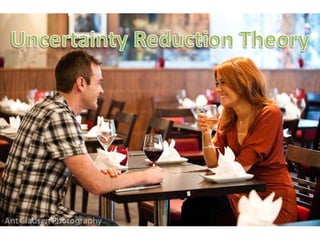Topic Top 5 presentation- Uncertainty Reduction Theory
•Als PPTX, PDF herunterladen•
1 gefällt mir•2,294 views
Melden
Teilen
Melden
Teilen

Empfohlen
Weitere ähnliche Inhalte
Andere mochten auch
Andere mochten auch (15)
Uncertainty Reduction Theory- Katie Corbin & Haley Sudduth- COMM 301

Uncertainty Reduction Theory- Katie Corbin & Haley Sudduth- COMM 301
Ähnlich wie Topic Top 5 presentation- Uncertainty Reduction Theory
Ähnlich wie Topic Top 5 presentation- Uncertainty Reduction Theory (10)
Implicit Theories of Relationships Orientations TowardEvalu

Implicit Theories of Relationships Orientations TowardEvalu
Affiliation and Attraction Social psychologists have studied aff.docx

Affiliation and Attraction Social psychologists have studied aff.docx
ArticleCan you connect withme now How thepresence of .docx

ArticleCan you connect withme now How thepresence of .docx
ArticleCan you connect withme now How thepresence of .docx

ArticleCan you connect withme now How thepresence of .docx
Kürzlich hochgeladen
Kürzlich hochgeladen (20)
Connector Corner: Accelerate revenue generation using UiPath API-centric busi...

Connector Corner: Accelerate revenue generation using UiPath API-centric busi...
Polkadot JAM Slides - Token2049 - By Dr. Gavin Wood

Polkadot JAM Slides - Token2049 - By Dr. Gavin Wood
CNIC Information System with Pakdata Cf In Pakistan

CNIC Information System with Pakdata Cf In Pakistan
Exploring the Future Potential of AI-Enabled Smartphone Processors

Exploring the Future Potential of AI-Enabled Smartphone Processors
EMPOWERMENT TECHNOLOGY GRADE 11 QUARTER 2 REVIEWER

EMPOWERMENT TECHNOLOGY GRADE 11 QUARTER 2 REVIEWER
Biography Of Angeliki Cooney | Senior Vice President Life Sciences | Albany, ...

Biography Of Angeliki Cooney | Senior Vice President Life Sciences | Albany, ...
Modular Monolith - a Practical Alternative to Microservices @ Devoxx UK 2024

Modular Monolith - a Practical Alternative to Microservices @ Devoxx UK 2024
Apidays New York 2024 - The value of a flexible API Management solution for O...

Apidays New York 2024 - The value of a flexible API Management solution for O...
Emergent Methods: Multi-lingual narrative tracking in the news - real-time ex...

Emergent Methods: Multi-lingual narrative tracking in the news - real-time ex...
Finding Java's Hidden Performance Traps @ DevoxxUK 2024

Finding Java's Hidden Performance Traps @ DevoxxUK 2024
Boost Fertility New Invention Ups Success Rates.pdf

Boost Fertility New Invention Ups Success Rates.pdf
DEV meet-up UiPath Document Understanding May 7 2024 Amsterdam

DEV meet-up UiPath Document Understanding May 7 2024 Amsterdam
Cloud Frontiers: A Deep Dive into Serverless Spatial Data and FME

Cloud Frontiers: A Deep Dive into Serverless Spatial Data and FME
Apidays New York 2024 - The Good, the Bad and the Governed by David O'Neill, ...

Apidays New York 2024 - The Good, the Bad and the Governed by David O'Neill, ...
Topic Top 5 presentation- Uncertainty Reduction Theory
- 3. The Uncertainty Reduction Theory explains and predicts interpersonal communication during the beginning of an interation. A core assumption of this theory is that when strangers meet, they seek to reduce uncertainty about each other
- 5. Berger (1979) and Calabrese (1975) intially presented this theory as a series of axioms theoroms that describe the relationships between uncertainty and several communication factors.
- 6. Using interviews and questionnaires, Parks and Adelman found that people who received support for their romantic involvement from family and friends expressed less uncertainty about their relationships.
- 8. Critics have argued that reducing uncertainty is not the driving force of interaction. Michael Sunnafrank’s predicted outcome value theory (1986) indicated that the actual motivation for interaction is a desire for positive relational experiences.
- 9. REFERENCES • Infante, D. A., Rancer, A. S., & Avtgis, T. A. (2010). Contemporary communication theory. (1 ed., Vol. 1, pp. 252-257). Dubuque, IA: Kendall Hunt Publishing Company. • Images from Google